So where exactly is Papua New Guinea or PNG as it is affectionately known?
Crudely, if you draw a line straight up, north from Cairns in Australia’s Queensland, you will get to Port Moresby, PNG’s capital. The first time the Beetle visited PNG, she flew from Cairns (about 2 hours) – a big mistake as it is far easier, quicker and cheaper to fly from the UK to Singapore and then take one of the twice weekly Air Nuigini flights from Singapore to Port Moresby. Jon, a Beetle friend says that depending on the season, flying from Cairns to Port Moresby can be cheaper than flying from Singapore.
The Beetle has a soft spot for PNG, for once you get outside Port Moresby which does not have such a good feel to it – and I am not talking about staying in one of the hotels close to the airport – that is not the real Port Moresby – Papua New Guinea is a delight; not easy to travel around, you need to take flights, but the people are hospitable and friendly, the scenery stunning and so very different to the normal south Pacific type adventure. From lush jungles, to volcanoes, to mountains, fabulous walking trails, birds of paradise, WWII remains, it has so much to offer.
The Beetle always calls in on PNG Arts when she is Port Moresby. As I said, you are wise to exercise considerable caution when visiting Port Moresby, but if you have time to visit just one place, then it has to be PNG Arts for all manner of artisan objects – from salt and pepper shakers in vaguely silly erotic shapes to ceremonial shields, (not as naff as it sounds) coffee tables and all manner of furniture, pictures and carved wooden animals. Most of the work on sale is crafted by PNG people in the outlying villages, mountains and islands and much of it is sold on a cooperative basis.
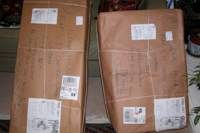 You don’t need to worry about getting your newly acquired purchases home as PNG Arts has a reliable packing, crating and shipping service, which the Beetle has twice used and all items arrived safely in London, taking about three months – see the very exciting picture left.
You don’t need to worry about getting your newly acquired purchases home as PNG Arts has a reliable packing, crating and shipping service, which the Beetle has twice used and all items arrived safely in London, taking about three months – see the very exciting picture left.
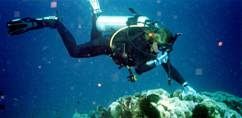 Anyway, down to business, this is not an ad for PNG Art, the Beetle wants to talk about Rabaul. Rabaul is a natural harbour on one of PNG’s islands, this one is New Britain, part of the Bismark Archipelago, which is immediately north of the main part of PNG. Rabaul has a sheltered deep harbour which allows good anchorage for large cargo and cruise ships. The harbour itself is a massive flooded caldera of an ancient volcano – it here that the Beetle did many fantastic dives. See the picture above right of a very undignified Beetle hanging on to some dead coral for dear life as the currents threatened to wash her away.
Anyway, down to business, this is not an ad for PNG Art, the Beetle wants to talk about Rabaul. Rabaul is a natural harbour on one of PNG’s islands, this one is New Britain, part of the Bismark Archipelago, which is immediately north of the main part of PNG. Rabaul has a sheltered deep harbour which allows good anchorage for large cargo and cruise ships. The harbour itself is a massive flooded caldera of an ancient volcano – it here that the Beetle did many fantastic dives. See the picture above right of a very undignified Beetle hanging on to some dead coral for dear life as the currents threatened to wash her away.
 From 1910 until 1937 Rabaul was under German control and the base of Japanese activities in the South Pacific during World War II and there are many remains and relics to be seen as a result of this and subsequent Japanese occupation.
From 1910 until 1937 Rabaul was under German control and the base of Japanese activities in the South Pacific during World War II and there are many remains and relics to be seen as a result of this and subsequent Japanese occupation.
Rabaul has an unfortunate cycle of devastating volcano eruptions. They appear to happen on a 50 or 60 year basis, which is how long it takes for the magma to build up a plug which will eventually have to be removed – by erupting. The last eruption happened in 1994 and prior to that, it was in 1937 and 1878. The 1994 eruption destroyed most of Rabaul so a new capital, Kokopo, was built 20km away, and the new airport is at Tokua, a little farther away on the far side of the caldera. There are still buildings around the volcano in Rabaul and there still is a town of Rabaul (the Beetle stayed there) though it is now on a much smaller scale.
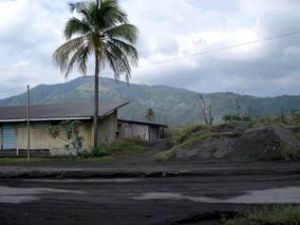
The picture above left shows the volcano still gently steaming away as it has continued to do so since 1994; it was very disconcerting to be diving so close to an active volcano.
The picture right shows Rabaul submerged by ash.
Other than diving, which was the Beetle’s principal reason for being in PNG, there is a lot to do and see. It is easy to organise a day trip to take a look around the area; best not done on a Friday as this is pay day and some of the local men get drunk and you may be a little limited as to where you can go – the Beetle could not visit the cemetery, for example, because its entrance was blocked by men boozing and it was not worth the hassle – not that we are trying to give PNG men a bad name, but there is a fair amount of alcohol abuse which can be seen throughout the South Pacific.
The Kokopo War Museum
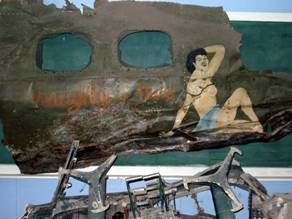 If you have an interest in WW2 artefacts and wish to gain a better understanding of the events in this part of the South Pacific, there is no better place to visit than the Kokopo war museum. It is largely set outdoor amidst beautifully manicured gardens with a gorgeous collection of frangipani ad star fruit trees.
If you have an interest in WW2 artefacts and wish to gain a better understanding of the events in this part of the South Pacific, there is no better place to visit than the Kokopo war museum. It is largely set outdoor amidst beautifully manicured gardens with a gorgeous collection of frangipani ad star fruit trees. 
The museum collection comprising mostly Japanese artefacts was largely assembled and donated by the efforts of Brian Bennett. The collection contains a large collection of WWII artefacts from the Rabaul relating to the history of the area, including the  German colonial period, pre-war and WWII Japanese occupation such as tanks, search lights, munitions, motorcycles, half-tracks, guns, artillery, machine guns, and the wrecks and partial wreck of many Japanese aircraft.
German colonial period, pre-war and WWII Japanese occupation such as tanks, search lights, munitions, motorcycles, half-tracks, guns, artillery, machine guns, and the wrecks and partial wreck of many Japanese aircraft.
There are also displays of local art and culture. There are some very poignant exhibits, including letters home by various servicemen describing their war time activities. According to Steve Mago who writes on the PNG Forum, (and has been a former contributor to the Globetrotter e-newsletter,) at the height of the war, 97,000 Japanese troops were stationed in Rabaul and its surrounding areas. There were also thousands of Allied POW’s, slave labourers and even 800 prostitutes from Korean and Japan. 
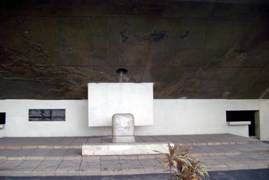 Japanese War Memorial A war memorial was constructed by the Japanese after WWII as a peace memorial, and in memory to those who lost their life in and around Rabaul. It is on a hill above the town, with a fabulous view of the area that was once occupied by thousands of Japanese Navy and Army personnel. The memorial is not without a little controversy. The huge map of the Pacific with New Britain and Rabaul at the centre forms the background of the memorial also
shows the sites of Jap
anese conquests. This elicited a response from the Australian government that the memorial signified Japanese occupation rather than promote their subsequent peaceful intentions. You can see in the Beetle photo left that there is a hole that lets the sun shine directly onto a simple pillar shrine.
Japanese War Memorial A war memorial was constructed by the Japanese after WWII as a peace memorial, and in memory to those who lost their life in and around Rabaul. It is on a hill above the town, with a fabulous view of the area that was once occupied by thousands of Japanese Navy and Army personnel. The memorial is not without a little controversy. The huge map of the Pacific with New Britain and Rabaul at the centre forms the background of the memorial also
shows the sites of Jap
anese conquests. This elicited a response from the Australian government that the memorial signified Japanese occupation rather than promote their subsequent peaceful intentions. You can see in the Beetle photo left that there is a hole that lets the sun shine directly onto a simple pillar shrine.
There is a volcano observation station high on a hill where visitors can go and meet with the seismologist staff and see the graph paper slowly moving round with squiggles indication volcanic movement.
The road up to the Observation Centre has a series of well developed cave and tunnel systems, as does nearly every other road and ravine in the town area of Rabaul.
Close to the memorial are some bunkers with Japanese writing in them as the photo right shows. 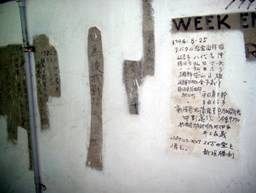
There is a volcano observation station high on a hill where visitors can go and meet with the seismologist staff and see the graph paper slowly moving round with squiggles indication volcanic movement.
The road up to the Observation Centre has a series of well developed cave and tunnel systems, as does nearly every other road and ravine in the town area of Rabaul.
Tunnels and Barges
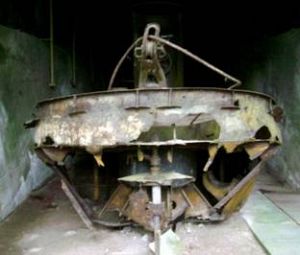 The Japanese used forced labour to build a series of tunnels through many parts of Rabaul. You can still see these tunnels sixty years later. Some of the tunnels were used to live in, store munitions and guns, and others were used to house barges. The Beetle photo left shows the remains of one such barge. One tunnel in particular is large enough to have stored five landing craft. During the war, these were carefully lifted out of the tunnel using a hoist system, taken across to the cliff face where they were lowered into the water.
The Japanese used forced labour to build a series of tunnels through many parts of Rabaul. You can still see these tunnels sixty years later. Some of the tunnels were used to live in, store munitions and guns, and others were used to house barges. The Beetle photo left shows the remains of one such barge. One tunnel in particular is large enough to have stored five landing craft. During the war, these were carefully lifted out of the tunnel using a hoist system, taken across to the cliff face where they were lowered into the water.
